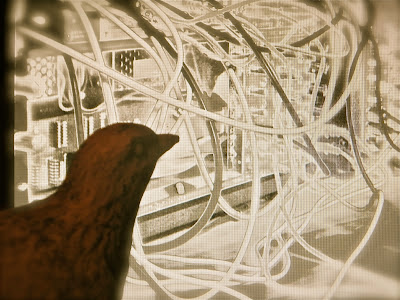Well there are so many things that you can do with the module for example, you can use the Gate Input or Button to fire each section, and send the positive output to the CV input of one Filter (Low Pass), and the Inverted Output to another Filter (High Pass) ...
Feeding your audio signal into the two filters in series, (output of one filter into, into the input of another). and firing a Transient (Envelope) will give you VC Divergence just like a Moog Filter Coupler and the 4T will spread and close the cutoff frequency like parting curtains.
How you adjust the filters makes a great difference, with lots of possibilities. (Try the same patch with two oscillators instead of two filters, like a Moog VCO Controller etc).
Another is to take the UP Output of one Transient section, and feed that into the Gate Input of another, and the UP Output of that one, into the Gate Input of another to form a chain. Intercepting one of these with a DC coupled VCA (that can process control voltage signals and not just audio, such as our Octal VCA).
Will make a great wobbly thing when the VCA (s) are varied. (Also rhythmic variation is always available by pressing and holding the big red buttons, those can be played musically too!)
Another is to take ~audio~ and feed it into the Gate Input and listen to the output, the Transients can be much much faster than typical Envelope Generators and in this regard the module can act as a Quad Waveshaper, or just use one or two sections to do that, and use the others as Envelopes to modify the Time Input on the others.
The Quick transients make super duper snappy envelopes great for percussion or for ringing Filters. Can be used for Low Pass Gate "Buchla Banjo" sounds as a CV input to the LPG (or Filter) instead of tight narrow pulses from a VCO or LFO) . Try an electric guitar as audio!
Of course mixing the Outputs of the Transients together with common (or Especially UN-common) Gate or Time CV inputs - makes some pretty wild event generators! You can tap the output of each Transient section out to somewhere in your patch, and then bring the outputs of those effected VCOs, or other Envelopes, Filters, etc
Back into the CV inputs of other 4T sections... and then take the resulting mix of all of the Transient sections out to process the results of all the other stuff!
You can make a "ring of firing Transients" using the Quadrature Outputs of your Zeroscillator into each of the separate Transient sections, and then play with the Time Input CVs. (Also try feeding the Transient sections ~Back Into~ any four VC Inputs of the Zeroscillator that is creating the Quadrature 4T firing in the first place.
Or, try mixing the UP Output with the Inverted Output of any particular Four Transients section, and then make a ring of that using other transient sections.
If you have Four Filters then you can carefully adjust the separate sections of the Transients into the filters and create cool and ~controllable~ Vocal sounds. If a Zeroscillator is the incoming audio to the filters, then try feeding an output of a Transient section into the Time Reversal Input of the ZO, and you will get
really wild vocal sounds.
Use the separate Gate Outs of a Sequencer, to fire off different Transient and filter combinations, and with careful adjustment and the audio in series,through those filters, you just may be able to make your synth speak, or say your name Arrrr-Th'uurrrr!
Ok, those are just a few suggestions.
(Sorry it's hard to stop once you get your imagination going with all of the Four Transients possibilities, lol) For example if you're running a sequencer and need an event to start say with a long slow attack on the pulse output of stage 4 (the fourth musical note in your sequence)...
usually with a sequencer running quickly, a traditional envelope doesn't have time to start that slow attack, let alone complete the whole envelope cycle, so pulling out the knob on the right side of each transient section will allow the envelope(s) to fully complete their cycle (or MIX of cycles) even though the stimulus
or sequencer has already moved onto other stages in the sequence. This is like once you launch an event, it will complete its mission autonomously. Or.., just push in the right side knob if you want to try something else.

No comments:
Post a Comment